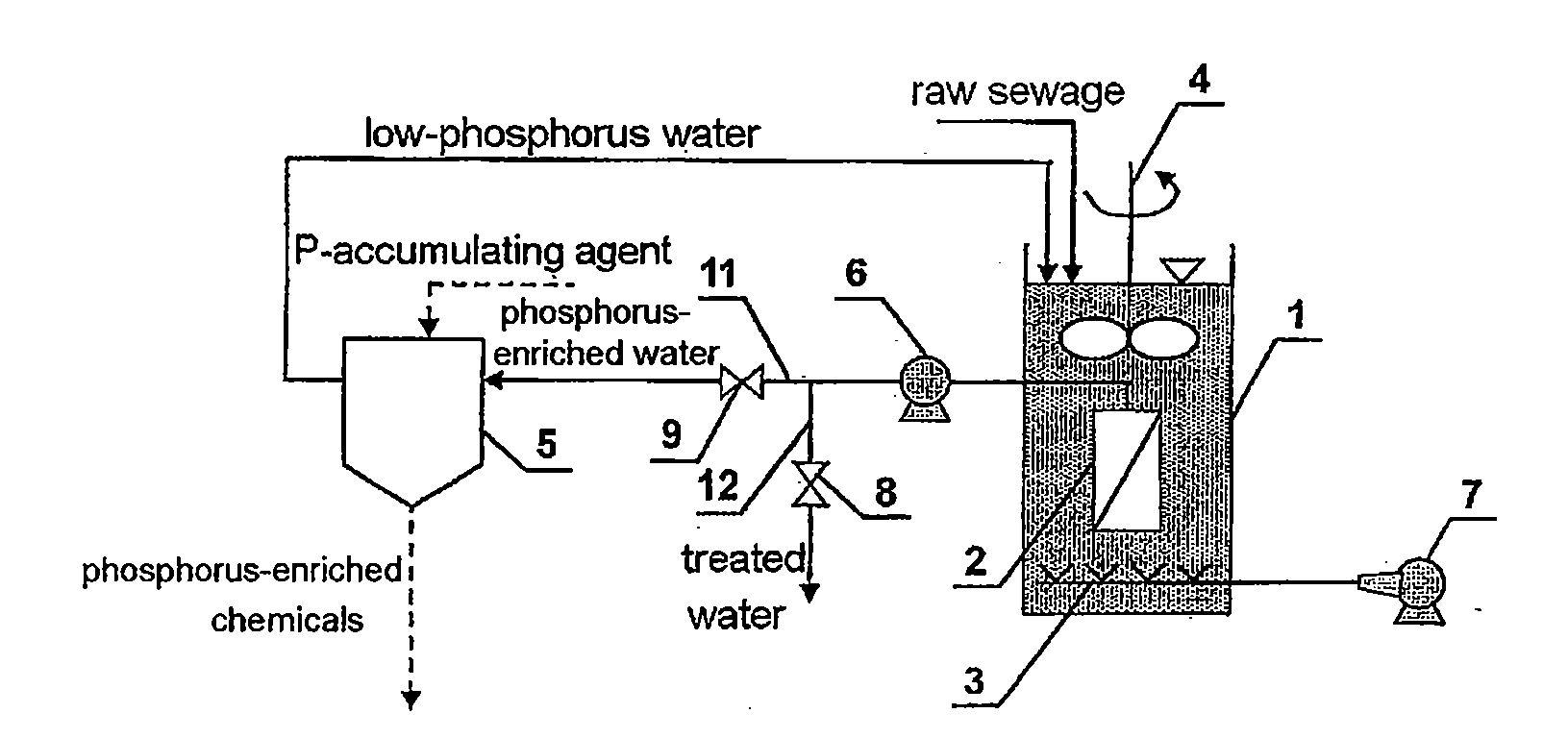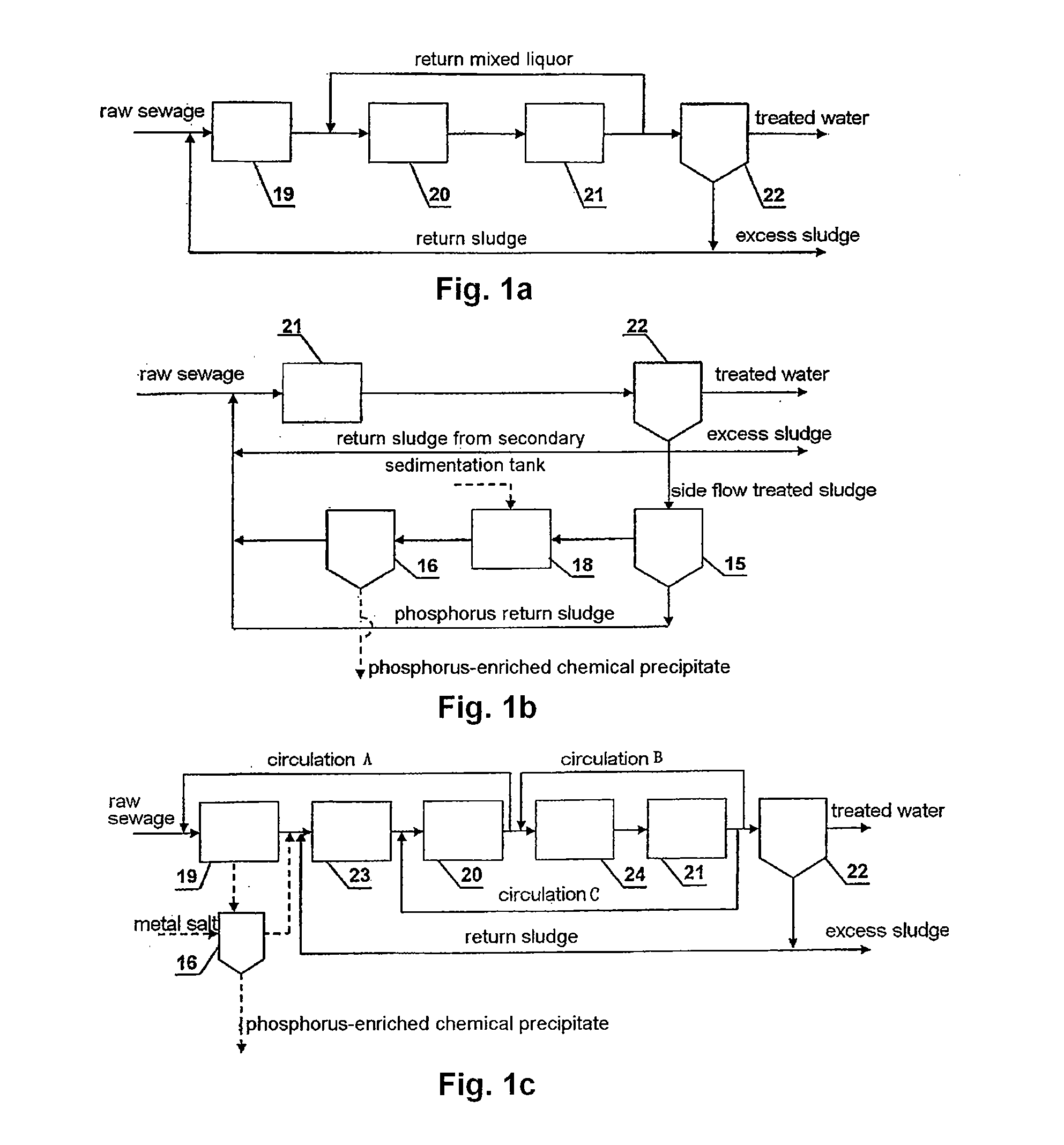Sewage Treatment Process and System
a technology of sewage treatment and sewage treatment, applied in the direction of biological water/sewage treatment, water/sewage multi-stage treatment, separation process, etc., to achieve the effect of reducing construction space utilization, reducing water quality, and flexible control of sludge ag
- Summary
- Abstract
- Description
- Claims
- Application Information
AI Technical Summary
Benefits of technology
Problems solved by technology
Method used
Image
Examples
example 1
[0100]As shown in FIG. 4a, a sewage treatment system comprises a biological reaction tank 1, a membrane separation device 2 installed inside the biological reaction tank 1, an aeration device 3 and a stirring device 4, a phosphorus recyling unit 5 installed outside the biological reaction tank 1, a suction pump 6 whose suction port is communicated to water outlet of the membrane separation device 2, a blower whose gas outlet is communicated to the gas inlet of the aeration device 3. The pipeline communicated to the water outlet of the suction pump 6 is divided into two branch pipelines, i.e. the first aqueduct 11 and the second aqueduct 12, wherein the first aqueduct 11 is communicated to a produced water collecting device, the second aqueduct 12 is communicated to the water inlet of the phosphorus recyling unit 5 whose water outlet is communicated to the biological reaction tank 1 by pipeline. An electrically operated valve is installed on each of the first aqueduct 11 and the seco...
example 2
[0108]As shown in FIG. 4b, a sewage treatment system is provided, most structures of which are the same as the Example 1, except that the membrane separation device 2 is disposed outside of the biological reaction tank 1, the biological reaction tank 1 and the membrane separation device 2 are communicated through liquor supply pipe 25 and liquor backflow pipe 26, wherein circulating pumps 10 is disposed on the liquor supply pipe 25. There are 6 circulating pumps 10, four in use and two for backup, the flow rate of each one being 800 m3 / h, the pump lift thereof being 12 m, and the power thereof being 45 kW. No suction pump is provided in the sewage treatment system of the invention, and the pre-treat device at the early stage thereof is the same as that in Example 1.
[0109]There 200 members of membrane separation device 2 which are divided into 4 groups, 50 for each group. Every group is arranged in two rows each having 25 devices. The contour dimension of each membrane separation dev...
example 3
[0113]As shown in FIG. 4c, a sewage treatment system is provided, most structures of which are the same as the Example 1, except that the membrane separation device 2 is disposed in membrane filter tank 13 which is independent from the biological reaction tank 1, and aeration device 3 are arranged in both the biological reaction tank 1 and the membrane filter tank 13, while the stirring device 4 is disposed only in the biological reaction tank 1. The biological reaction tank 1 and the membrane filter tank 13 are communicated through a liquor supply pipe 25 and a liquor backflow pipe 26, wherein a circulating pumps 10 is disposed on the liquor backflow pipe 26. There are 6 circulating pumps 10, four in use and two for backup, the flow rate of each one being 800 m3 / h, the pump lift thereof being 12 m, and the power thereof being 45 kW. The pipeline communicated to the gas outlet of the blower 7 is divided into two branch pipelines, one of which is communicated to the aeration device 3...
PUM
| Property | Measurement | Unit |
|---|---|---|
| concentration | aaaaa | aaaaa |
| concentration | aaaaa | aaaaa |
| concentration | aaaaa | aaaaa |
Abstract
Description
Claims
Application Information
 Login to View More
Login to View More - R&D
- Intellectual Property
- Life Sciences
- Materials
- Tech Scout
- Unparalleled Data Quality
- Higher Quality Content
- 60% Fewer Hallucinations
Browse by: Latest US Patents, China's latest patents, Technical Efficacy Thesaurus, Application Domain, Technology Topic, Popular Technical Reports.
© 2025 PatSnap. All rights reserved.Legal|Privacy policy|Modern Slavery Act Transparency Statement|Sitemap|About US| Contact US: help@patsnap.com



